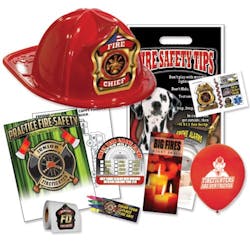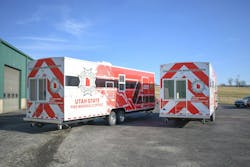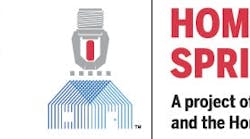Any parent can tell you that to get children to eat undesired yet needed and healthful food, such as vegetables, you must be creative. Sometimes, you must sneak those vegetables in for the children’s own good, where they consume them without realizing it—and maybe even come to find that they like them after all. Educating your community on data-driven risks can be just like that.
Ahead of the curve
We are advocates for not waiting for data—or illnesses and injuries—to rise to the point of something being a significant risk to the community that must be addressed. When one waits, lives and property are affected and lost, which is the opposite of our purpose. Now, not waiting for data doesn’t mean that we operate willy-nilly. It still involves data analysis. Community risk reduction (CRR) personnel must have their finger on the pulse of not just the community but also the state and nation. This helps to identify emerging risks that statistically and realistically will affect the community.
For example, opiates now are an established national risk that affects all states, counties and communities, and we saw that this emerging risk eventually would affect the citizens of our communities. By analyzing our EMS response data and seeing overdoses as an increasing call for service—even though it didn’t top our list at the time as a current prominent risk—we clearly saw that if the risk wasn’t addressed immediately, the data eventually would leave us no choice. However, by then, lives and families would be ruined or lost. So why wait?
As this national epidemic grew—as did our department’s data on opiates and overdoses—the medical training officer, seeing this risk coming, began preparations within the agency and began to reach out to other stakeholders. As conversations with the stakeholders expanded, it was realized that a larger problem was looming countywide that would be beyond local resources to address.
In 2021, the U.S. Department of Health and Human Services’ Substance Abuse and Mental Health Services Administration (SAMHSA) awarded our county a four-year, $1,934,988 grant to address the opiate problem. This was to be done via a process of increasing education and expanding the distribution of Naloxone (Narcan) in addition to providing support for those who have utilized emergency services because of opiate use.
The grant led to the creation of a collaborative team of stakeholders: two fire districts, county EMS services, local law enforcement and the county’s substance abuse office. This team—First Responders Project—consists of two firefighter/EMTs, a paramedic, two certified drug counselors and a program administrator. A governing board of fire chiefs, department heads from the participating agencies, and a law enforcement representative oversees the team and program.
Being creative
Now, just because an agency discovers a risk through data analysis, it doesn’t mean that members of the community will share that same perspective.
Initially, speaking engagements for the First Responders Project team were cancelled by various entities once they realized that the topic would be opiates and overdoses, and future outreach attempts were met with no interest. It appeared that our citizens didn’t share our risk concern and didn’t want to acknowledge that this risk—or in their terms, a drug problem—was present in the community. However, sometimes you must sneak those needed vegetables onto the desired menu for people to consume and remain healthy. Our district added the First Responders Project into our already established and successful Immediate Responder outreach program.
Previous data analysis showed that we were teaching an increasing number of CPR classes. Because of the popularity and need for CPR training, we added our Stop the Bleed program to it and created one single outreach program—the Immediate Responder program—sneaking those needed vegetables onto that desired menu. By now adding the First Responders Project and the education and training on opiates and Narcan use to the established and successful Immediate Responder program, we simply added one more vegetable to the desired CPR menu.
Because of our existing community partnership with our school district, we were providing the Immediate Responder program free of charge to not only teachers and staff but also their families through monthly and quarterly training. Because these teachers and staff also are members of our community, not only were the number of community Immediate Responders increased, but word began to spread about the program, which led to more invitations from churches, social groups, businesses and numerous other organizations. It appeared that the initial resistance to accepting opiates and overdoses as a risk to be addressed within the community abated and the topic became more palatable to members of the community. Those vegetables weren’t so bad after all.
This proactive approach also produced another tremendous CRR benefit. Up until recently, by law in South Carolina, school teachers and staff, including school nurses, weren’t allowed to carry or use Narcan on school property. So, during our first year-and-a-half of monthly and quarterly training with the school district, we had to emphasize that the training that they received on Narcan was for personal knowledge and use. However, when the law was changed and Narcan kits began to be mounted in schools, approximately 200 teachers and staff already received the knowledge and training on how to use the kit. In other words, on the very day that the law was changed—and before the risk showed up in the schools—teachers and staff already were prepared to address the risk.
Delivering relationships
In addition to the outreach education and training, each day, the team meets to evaluate local, state and national data on potential overdoses that occurred within the previous 24 hours. If an incident occurred within our county, the team creates a plan to visit the individual at that person’s home of record and to meet with family members. Although law enforcement generally isn’t a part of the contact team, if there is any indication or concern for safety, a law enforcement officer accompanies the team, although not being directly involved. The contact team—an EMT and certified drug counselor—checks on the well-being of the individual and provides Narcan to the family along with training, but, most importantly, the drug counselor develops a relationship with the individual to support and encourage that person to get the help that he or she might need.
Success
Our four-year grant recently passed the two-and-a-half-year mark. During that time, we have taught CPR, Stop the Bleed and opioid/Narcan awareness to more than 1,500 new Immediate Responders in our community. We conducted approximately 130 additional community outreach programs to educate citizens on the dangers of opiates and on the benefits of Narcan and provided approximately 800 doses of Narcan to trained citizens. The team also made contact with more than 120 residents who utilized emergency services because of opiate use. Thirty-two of those residents entered recovery or assistance programs.
Discovering a risk is only 10 percent of the process; educating your community on that risk and that it must be addressed is 70 percent of it. (The remaining 20 percent is carrying out the program.) This is complicated further when it’s a looming risk (COVID, opiates, etc.)—in other words, not currently immediate—that will be devastating when it does come. We learned that CPR was a much sought-after training—or the dessert on the menu, if you will. Trying to address Stop the Bleed and opiates/Narcan as separate programs—the vegetables, so to speak—wasn’t working, because the community didn’t see the need nor have any interest. By combining the much-desired training with the not-so-desired, but nevertheless important, training, we were able to get this needed information into the community. More importantly, many members of the community began to realize these risks and the importance of being educated and trained and became some of our biggest advocates for the program and training.
The plan
You know the risks for your community, and you know what must be done, but your community might not agree. Find out what training and education is sought—the desired menu items—and add the training that you know that they need to stay healthy and safe—the vegetables. By getting that information and education into the community in a less direct and more receptive manner, you might be surprised at the result. Undoubtedly, so will they.
Product Spotlight
Home Fire Sprinklers & CRR
A house fire can become deadly in two minutes because of modern construction methods, synthetic materials and furnishings, and emerging technology, such as lithium-ion batteries. Home fire sprinklers are the only proven technology that can stop a fire from becoming deadly and protect residents and responding firefighters. The Home Fire Sprinkler Coalition stresses that proven community risk reduction (CRR) includes protecting all new homes with fire sprinklers.
Fire Prevention for Everyone
With something for both children and adults, an Open House Deluxe Pack from Alert-All is a great way to stretch a thin budget while still teaching the important message of fire prevention. Each Deluxe Pack includes 100 pieces of 10 different items, including fire chief hats, coloring books, crayons and fire safety magnets, plus a roll of 200 stickers, for a total of 1,200 items.
FIRE SAFETY HOUSE
The Utah State Fire Marshal’s Office in Sandy, UT, worked with Mobile Concepts Specialty Vehicles to develop two fire safety houses. The 3500 Fire Safety House has three areas where citizens can learn about fire safety and risk reduction: a bedroom, a kitchen and a living room. Each space has interactive learning elements, including simulated fire and theatrical smoke, smoke alarms, an escape window and a ladder.









